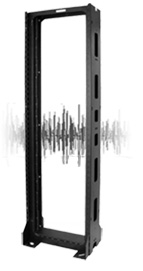
Have you ever wondered if you really need a special equipment rack in seismically active areas? The short answer is “yes.” Using a rack or cabinet that is designed for seismic applications may be more costly, but it will give you the highest load bearing capacity in your designated floor space.
The Benefits of Seismic Racks
One of the main purposes of an equipment rack is to store a large amount of equipment while using a relatively small amount of floor space in your room. Essentially, it lets you stack equipment vertically. The EIA-310 standard is universally adopted, so you can easily designate a number of vertical rack-mount spaces (U) for equipment. What changes from rack to rack and manufacturer to manufacturer is the rated load capacity, which is the amount of weight that the rack can safely hold.
Seek a solution with the highest load for each rack, even if you do not need it immediately. This maximizes load per U, which is the way to realize the best value from the designated floor space and the rack.
Why Seismic Racks Are Different
The seismic equipment load of a rack will be less than its static equipment load, unless the rack is specifically designed for seismic applications. Racks specifically designed for seismic applications will have heavily braced frames to resist side-to-side, front-back, and up-down motion. Most manufacturers will load-test these racks on a shaker test table that simulates a seismic event to demonstrate rack performance, and verify their load claim.
The rack has to survive the test with no structural damage. A motion limit has to be maintained throughout the test. The International Code Council (ICC), which publishes the International Building Code (IBC), the model code in the United States, publishes seismic test procedure ICC ES AC-156. To see how these racks work in the field, watch a short video that demonstrates how a shaker table test works.
Choosing the Right Rack
So, which rack or cabinet should you use? The building code requires that a licensed structural engineer design the components, supports and attachments for nonstructural building components such as equipment racks. That means an engineer defines the exact installation hardware, placement and materials that attach the rack to the floor and, if necessary, how it will be braced overhead. The design includes a calculation to determine the seismic load. With this design, you can use any rack in a seismic area. However, the penalty may be a greatly reduced equipment load if you do not select a rack specifically designed for seismic applications.
Racks that are specifically designed for seismic applications are more expensive than non-seismic racks, but they generally have higher load ratings and can be filled with equipment. With non-seismic racks, you may need multiple racks to hold your gear.
Learn more about CPI’s seismic protection systems, or configure a product now.
David Knapp, CPI Product Marketing Manager